Debre Nazret
Debre Nazret is a tabia or municipality in the Dogu'a Tembien district of the Tigray Region of Ethiopia. The tabia centre is in Togogwa village, located approximately 19 km to the east-southeast of the woreda town Hagere Selam.
Debre Nazret Togogwa | |
|---|---|
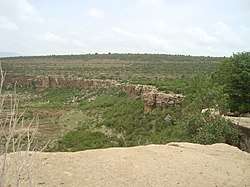 The Limestone landscape of Debre Nazret | |
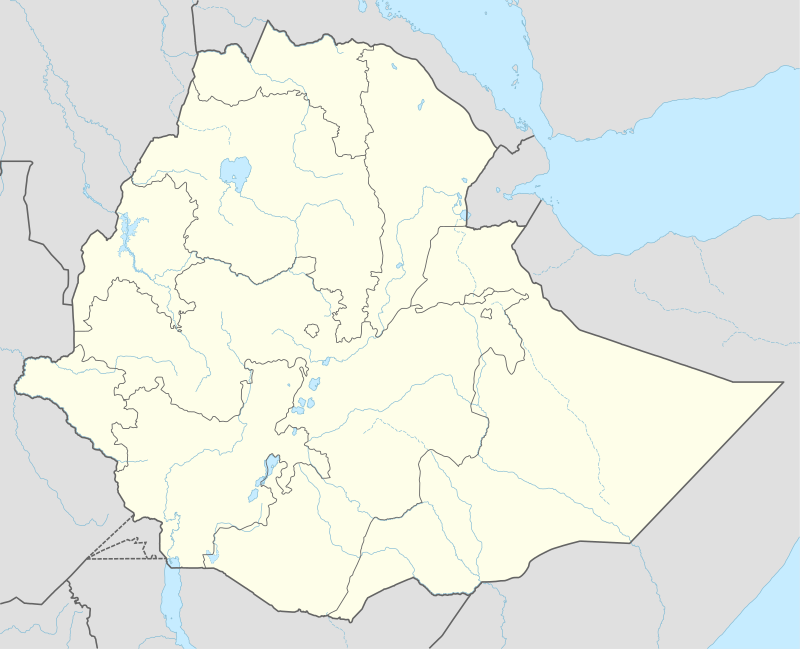 Debre Nazret Location within Ethiopia | |
| Coordinates: 13°34′N 39°18′E | |
| Country | Ethiopia |
| Region | Tigray |
| Zone | Debub Misraqawi (Southeastern) |
| Woreda | Dogu'a Tembien |
| Area | |
| • Land | 91.54 km2 (35.34 sq mi) |
| Elevation | 2,150 m (7,050 ft) |
| Time zone | UTC+3 (EAT) |
Geography
The tabia occupies a wide limestone plateau at the southeast of the Dogu'a Tembien district; at the eastern and southern side it is bound by the Giba River gorge and at the west by Addi Keshofo River. The highest peak is Imba Bete Gyergis (2390 m a.s.l.) and the lowest place the junction of Addi Keshofo and Giba Rivers (1600 m a.s.l.).
Geology
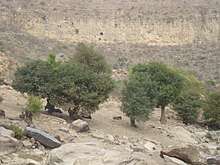
From the higher to the lower locations, the following geological formations are present:[1]
- Antalo Limestone
- Mekelle Dolerite[2]
- Quaternary alluvium and freshwater tufa[3]
Geomorphology and soils
The main geomorphic unit is the gently undulating Agula shale plateau with dolerite. Corresponding soil types are:[4]
Springs
As there are no permanent rivers, the presence of springs is of utmost importance for the local people. For instance, in Kolal, the spring is so poor that every family may fetch only 20 litres of water every two days. If they need more water they must go down to Giba River. The following are the most important springs in the tabia:[5]
- May Kebakebo in Mi'am Atali
- Ruba Minchi in Mi'am Atali
- May Togogwa in Togogwa
- May Bilbil in Giba River (the strong spring is inside the river bed)
May Kebakebo and May Togogwa directly feed Inda Anbesa River
Reservoirs
In this area with rains that last only for a couple of months per year, reservoirs of different sizes allow harvesting runoff from the rainy season for further use in the dry season.
- Traditional surface water harvesting ponds, particularly in places without permanent springs, called rahaya
- Horoyo, household ponds, recently constructed through campaigns[6]
Vegetation and exclosures
The tabia holds several exclosures, areas that are set aside for regreening.[7] Wood harvesting and livestock range are not allowed there. Besides effects on biodiversity,[8][9][10] water infiltration, protection from flooding, sediment deposition,[11] carbon sequestration,[12] people commonly have economic benefits from these exclosures through grass harvesting, beekeeping and other non-timber forest products.[13] The local inhabitants also consider it as “land set aside for future generations”.[14] In this tabia, some exclosures are managed by the EthioTrees project. They have as an additional benefit that the villagers receive carbon credits for the sequestered CO2,[15] as part of a carbon offset programme.[16] The revenues are then reinvested in the villages, according to the priorities of the communities;[17] it may be for an additional class in the village school, a water pond, or conservation in the exclosures. The following exclosures are managed by the Ethiotrees project in Debre Nazret:[18]
- Mi'am Atali (exclosure), near the homonymous village (76.75 ha)
- Togogwa (exclosure), near the homonymous small town (108.11 ha)
Livelihood
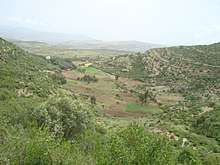
The population lives essentially from crop farming, supplemented with off-season work in nearby towns. The land is dominated by farmlands which are clearly demarcated and are cropped every year. Hence the agricultural system is a permanent upland farming system.[19] Additionally many steep slopes are currently being reforested, which led to decreased soil erosion and stabilisation of gullies. In the villages of Addi Reget and Kayeh Guila, the youngsters will go to the deep gorge of Giba river to harvest incense from Boswellia papyrifera trees.[20]
Population
The tabia centre Togogwa holds a few administrative offices, a health post, a primary and secondary school, and some small shops. Tuesday is the market day.[5] There are a few more primary schools across the tabia. The main other populated places are:[21]
|
|
Religion and churches
Most inhabitants are Orthodox Christians. The following churches are located in the tabia:
|
|
History
The history of the tabia is strongly confounded with the history of Tembien.
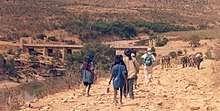
Schools
Almost all children of the tabia are schooled,[22] though in some schools there is lack of classrooms, directly related to the large intake in primary schools over the last decades.[23] Schools in the tabia include Togogwa High School and Kolal school.
Roads and communication
In the 1960s, a road was built from Mekelle through Togogwa to Hagere Selam and on to Abiy Addi. This involved building a bridge over Giba River; the bridge stands strong nowadays, but the road is largely disused. Yet the segment on the plateau that links Togogwa to the main road Mekelle – Hagere Selam – Abiy Addi. There are regular minibus services to Mekelle and Hagere Selam.
Tourism
Its mountainous nature and proximity to Mekelle makes the tabia fit for tourism.[24]
Touristic attractions
- Yohannes monastery
- Giba gorge
Geotouristic sites
The high variability of geological formations and the rugged topography invites for geological and geographic tourism or "geotourism".[25] Geosites in the tabia include:
- Peak of Imba Bete Giyergis
- May Bilbil resurgence
Birdwatching
Birdwatching (for the species, see the main Dogu'a Tembien page) can be done particularly in exclosures and forests. The following bird-watching sites have been inventoried[26] in the tabia and mapped.[21]
- Yohannes monastery forest
- Kolal church forest
- Mishlam church and slope forests
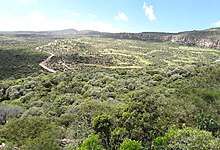
Trekking routes
Trekking routes have been established in this tabia.[27] The tracks are not marked on the ground but can be followed using downloaded .GPX files.[28]
- Trek 18, from the old bridge on Giba River to Addi Lihtsi across the southern part of Debre Nazret
- Trek 22, from the old bridge to Togogwa
- Trek 15, from Togogwa to the southwest (Addi Lihtsi)
- Trek 16, from Togogwa to the west (Rubaksa)
- Trek 17, from Togogwa to the north (Mizane Birhan)
Inda Siwa, the local beer houses
In the main villages, there are traditional beer houses (Inda Siwa), often in unique settings, which are a good place for resting and chatting with the local people. Most renown in the tabia are[5]
- Gebrisu Tsegay at Togogwa
- Tsega Assefa at Togogwa
- Tinsu'i Kiros at Togogwa
Accommodation and facilities
The facilities are very basic.[29] One may be invited to spend the night in a rural homestead or ask permission to pitch a tent. There are basic hotels in Togogwa, essentially to host pilgrims on their way to the Dabba Hadera monastery. Better hotels are available in Hagere Selam and Mekelle.
More detailed information
For more details on environment, agriculture, rural sociology, hydrology, ecology, culture, etc., see the overall page on the Dogu'a Tembien district.
References
- Sembroni, A.; Molin, P.; Dramis, F. (2019). Regional geology of the Dogu'a Tembien massif. In: Geo-trekking in Ethiopia's Tropical Mountains - The Dogu'a Tembien District. SpringerNature. ISBN 978-3-030-04954-6.
- Tefera, M.; Chernet, T.; Haro, W. Geological Map of Ethiopia (1:2,000,000). Addis Ababa, Ethiopia: Ethiopian Institute of Geological Survey.
- Moeyersons, J. and colleagues (2006). "Age and backfill/overfill stratigraphy of two tufa dams, Tigray Highlands, Ethiopia: Evidence for Late Pleistocene and Holocene wet conditions". Palaeogeography, Palaeoclimatology, Palaeoecology. 230 (1–2): 162–178.
- Nyssen, Jan; Tielens, Sander; Gebreyohannes, Tesfamichael; Araya, Tigist; Teka, Kassa; Van De Wauw, Johan; Degeyndt, Karen; Descheemaeker, Katrien; Amare, Kassa; Haile, Mitiku; Zenebe, Amanuel; Munro, Neil; Walraevens, Kristine; Gebrehiwot, Kindeya; Poesen, Jean; Frankl, Amaury; Tsegay, Alemtsehay; Deckers, Jozef (2019). "Understanding spatial patterns of soils for sustainable agriculture in northern Ethiopia's tropical mountains". PLoS ONE. 14 (10): e0224041. doi:10.1371/journal.pone.0224041. PMC 6804989. PMID 31639144.
- What do we hear from the farmers in Dogu'a Tembien? [in Tigrinya]. Hagere Selam, Ethiopia. 2016. p. 100.
- Developers and farmers intertwining interventions: the case of rainwater harvesting and food-for-work in Degua Temben, Tigray, Ethiopia
- Aerts, R; Nyssen, J; Mitiku Haile (2009). "On the difference between "exclosures" and "enclosures" in ecology and the environment". Journal of Arid Environments. 73: 762–763.
- Aerts, R.; Lerouge, F.; November, E. (2019). Birds of forests and open woodlands in the highlands of Dogu'a Tembien. In: Geo-trekking in Ethiopia's Tropical Mountains - The Dogu'a Tembien District. SpringerNature. ISBN 978-3-030-04954-6.
- Mastewal Yami, and colleagues (2007). "Impact of Area Enclosures on Density and Diversity of Large Wild Mammals: The Case of May Ba'ati, Douga Tembien Woreda, Central Tigray, Ethiopia". East African Journal of Sciences. 1: 1–14.
- Aerts, R; Lerouge, F; November, E; Lens, L; Hermy, M; Muys, B (2008). "Land rehabilitation and the conservation of birds in a degraded Afromontane landscape in northern Ethiopia". Biodiversity and Conservation. 17: 53–69. doi:10.1007/s10531-007-9230-2.
- Descheemaeker, K. and colleagues (2006). "Sediment deposition and pedogenesis in exclosures in the Tigray Highlands, Ethiopia". Geoderma. 132 (3–4): 291–314. doi:10.1016/j.geoderma.2005.04.027.
- Wolde Mekuria, and colleagues (2011). "Restoration of Ecosystem Carbon Stocks Following Exclosure Establishment in Communal Grazing Lands in Tigray, Ethiopia". Soil Science Society of America Journal. 75(1): 246.
- Bedru Babulo, and colleagues (2006). "Economic valuation methods of forest rehabilitation in exclosures". Journal of the Drylands. 1: 165–170.
- Jacob, M. and colleagues (2019). Exclosures as Primary Option for Reforestation in Dogu’a Tembien. In: Geo-trekking in Ethiopia's Tropical Mountains - The Dogu'a Tembien District. SpringerNature. ISBN 978-3-030-04954-6.
- Reubens, B. and colleagues (2019). Research-based development projects in Dogu’a Tembien. In: Geo-trekking in Ethiopia's Tropical Mountains - The Dogu'a Tembien District. SpringerNature. ISBN 978-3-030-04954-6.
- EthioTrees on Plan Vivo website
- EthioTrees on Davines website
- De Deyn, Jonathan (2019). Benefits of reforestation on Carbon storage and water infiltration in the context of climate mitigation in North Ethiopia. Master thesis, Ghent University, Belgium.
- Naudts, J (2002). Les Hautes Terres de Tembien, Tigré, Ethiopie; Résistance et limites d'une ancienne civilisation agraire; Conséquences sur la dégradation des terres [MSc dissertation]. CNEARC, Montpellier, France.
- Moens, T. and colleagues (2019). Boswellia Incense in the Giba River Gorge. In: Geo-trekking in Ethiopia's Tropical Mountains - The Dogu'a Tembien District. SpringerNature. doi:10.1007/978-3-030-04955-3_19. ISBN 978-3-030-04954-6.
- Jacob, M. and colleagues (2019). Geo-trekking map of Dogu'a Tembien (1:50,000). In: Geo-trekking in Ethiopia's Tropical Mountains - The Dogu'a Tembien District. SpringerNature. ISBN 978-3-030-04954-6.
- Socio-demographic profile, food insecurity and food-aid based response. In: Geo-trekking in Ethiopia's Tropical Mountains - The Dogu'a Tembien District. SpringerNature. 2019. ISBN 978-3-030-04954-6.
- Hartjen, C.A. and Priyadarsini, S., 2012. Denial of Education. In The Global Victimization of Children (pp. 271-321). Springer, Boston, MA. https://link.springer.com/chapter/10.1007/978-1-4614-2179-5_8 .
- Geo-trekking in Ethiopia's Tropical Mountains - The Dogu'a Tembien District. SpringerNature. 2019. ISBN 978-3-030-04954-6.
- Miruts Hagos and colleagues (2019). Geosites, Geoheritage, Human-Environment Interactions, and Sustainable Geotourism in Dogu'a Tembien. In: Geo-Trekking in Ethiopia's Tropical Mountains, the Dogu'a Tembien District. SpringerNature. doi:10.1007/978-3-030-04955-3_1. ISBN 978-3-030-04954-6.
- Aerts, R.; Lerouge, F.; November, E. (2019). Birds of forests and open woodlands in the highlands of Dogu'a Tembien. In: Geo-trekking in Ethiopia's Tropical Mountains - The Dogu'a Tembien District. SpringerNature. ISBN 978-3-030-04954-6.
- Nyssen, Jan (2019). Description of Trekking Routes in Dogu'a Tembien. GeoGuide. Springer-Nature. pp. 557–675. doi:10.1007/978-3-030-04955-3_38. ISBN 978-3-030-04954-6.
- https://www.openstreetmap.org/traces/tag/nyssen-jacob-frankl
- Nyssen, Jan (2019). "Logistics for the Trekker in a Rural Mountain District of Northern Ethiopia". Geo-trekking in Ethiopia's Tropical Mountains. GeoGuide. Springer-Nature. pp. 537–556. doi:10.1007/978-3-030-04955-3_37. ISBN 978-3-030-04954-6.